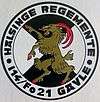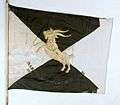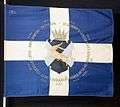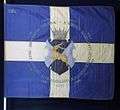Hälsinge Regiment
The Hälsinge Regiment[3] (Swedish: Hälsinge regemente), designations I 14, I 14/Fo 49 and I 14/Fo 21, was a Swedish Army infantry regiment that traced its origins back to the 16th century. It was disbanded in 1997. The regiment's soldiers were originally recruited from the provinces of Hälsingland and Gästrikland, and it was later garrisoned in Gästrikland.
| Hälsinge Regiment | |
|---|---|
| Hälsinge regemente | |
 | |
| Active | 1630–1709, 1709–1713, 1713–1997 |
| Country | |
| Allegiance | Swedish Armed Forces |
| Branch | Swedish Army |
| Type | Infantry |
| Size | Regiment |
| Part of | 5th Military District (1833–1889) 6th Military District (1889–1893) 6th Army Division (1893–1901) VI Army Division (1902–1927) Northern Army Division (1928–1936) II Army Division (1937–1943) II Military District (1943–1966) Eastern Military District (1966-1982) Lower Norrland Military District (1966-1982) Lower Norrland Military District (1982-1993) Middle Military District (1982-1993) |
| Garrison/HQ | Gävle |
| Motto(s) | "Fasthet, Förmåga, Förtroende" ("Solidity, Ability, Confidence")[Note1 1] |
| Colors | Black and white |
| March | "Marcia militaris" (Schmidt)[Note1 2] |
| Battle honours | Novgorod (1611), Warszawa (1656), Fredriksodde (1657), Tåget över Bält (1658), Lund (1676), Landskrona (1677), Narva (1700), Düna (1701), Jakobstadt (1704), Gemäuerthof (1705), Malatitze (1708), Gadebusch (1712) |
| Insignia | |
| Branch insignia m/60 | .png) |
| Unit insignia m/60 | .jpg) |
| Shoulder sleeve insignia |  |
History
The regiment has its origins in fänikor (companies) raised in Hälsingland and Gästrikland in the 1550s and 1560s. In 1615, these units—along with fänikor from the nearby provinces of Medelpad, Ångermanland and Västerbotten—were organised by Gustav II Adolf into Norrlands storregemente, of which eleven of the total 24 companies were recruited in Hälsingland and Gästrikland. Norrlands storregemente consisted of three field regiments, of which Hälsinge Regiment was one. Sometime around 1624, the grand regiment was permanently split into three smaller regiments, of which Hälsinge Regiment was one.
The regiment was officially raised in 1630 although it had existed since 1624. Hälsinge Regiment was one of the original 20 Swedish infantry regiments mentioned in the Swedish constitution of 1634. The regiment was also called Joakim Brahe's Regiment after its first commander Joakim Brahe. It was allotted in 1682 as the second Swedish regiment to be so, after Dalarna Regiment.
The regiment was given the designation I 14 (14th Infantry Regiment) in a general order in 1816. Hälsinge Regiment was garrisoned in Gävle from 1909. In 1973, the regiment gained the new designation I 14/Fo 49 as a consequence of a merge with the local defence area Fo 49. When the local defence area changed designation to Fo 21 in 1982, the designation changed to I 14/Fo 21. The regiment was disbanded in 1997, and the barracks that had been refurbished in 1995–1996 were turned into a college campus for the University College of Gävle.
Campaigns
- The Swedish War of Liberation (1521–1523)[Note1 3]
- The Northern Seven Years' War (1563–1570)[Note1 3]
- The War against Russia (1590–1595)[Note1 3]
- The Polish War (1600–1629)
- The Thirty Years' War (1630–1648)
- The Torstenson War (1643–1645)
- The Northern Wars (1655–1661)
- The Scanian War (1674–1679)
- The Great Northern War (1700–1721)
- The Hats' Russian War (1741–1743)
- The Seven Years' War (1757–1762)
- The Gustav III's Russian War (1788–1790)
- The Finnish War (1808–1809)
- The Campaign against Norway (1814)
Organisation
|
|
Heraldry and traditions
Colours, standards and guidons
The regiment have carried a number of colour over the years. In 1897, King Oscar II presented a new colour to the two battalions of the regiment, which then replaced the 1850 colour.[4] On 29 September 1952, the 1897 colour was replaced[4] when the regiment was presented with a new colour in Gävle by His Majesty the King Gustaf VI Adolf. It was used as regimental colour by I 14/Fo 21 until 1 January 1998.[5] The new colour was similar to the 1850 colour. It was white and black, which is also the regimental colour, and taken from Hälsingland (black) and Gästrikland (white).[4] The colour is drawn by Brita Grep. It has not been possible to discover who has manufactured the colour. It is embroidered by hand in insertion technique. Blazon: "On cloth per saltire black and white the provincial badge of Hälsingland; a rampant yellow buck, armed red. On a yellow border at the upper side of the colour, battle honours (Novgorod 1611, Warszawa 1656, Fredriksodde 1657, Tåget över Bält 1658, Lund 1676, Landskrona 1677, Narva 1700, Düna 1701, Jakobstadt 1704, Gemäuerthof 1705, Malatitze 1708, Gadebusch 1712) in black".[5]
 1850 colour of the 1st Battalion, Hälsinge Regiment.
1850 colour of the 1st Battalion, Hälsinge Regiment. 1897 colour of the 1st Battalion, Hälsinge Regiment.
1897 colour of the 1st Battalion, Hälsinge Regiment. 1897 colour of the 2nd Battalion, Hälsinge Regiment.
1897 colour of the 2nd Battalion, Hälsinge Regiment.
Coat of arms
The coat of the arms of the Hälsinge Regiment (I 14/Fo 21) 1977–1997 and the Gävleborg Group (Gävleborgsgruppen) since 1997. Blazon: The provincial badge of Hälsingland, saltire sable and argent, a buck rampant or, armed and langued gules. The shield surmounted two muskets in saltire or".[6]
Medals
In 1959, the Hälsinge regementes (I 14) förtjänstmedalj ("Hälsinge Regiment (I 14) Medal of Merit") in gold (HälsregGM) of the 8th size was established. The same year, the Kungl. Hälsinge regementes belöningsmedalj ("Royal Hälsinge Regiment Medal of Reward") in gold (HälsregGM) was established. In 1959 and 1985, the Hälsinge regementes förtjänstmedalj ("Hälsinge Regiment Medal of Merit") in silver (HälsregSM) were established. The medals from 1959 and 1982 are of the 8th size. In 1992, the medals were reinstated as a Jeton, but then of the 12th size. The medal ribbons are divided in black and white moiré.[7][8][9]
Commanding officers
Regimental commanders active at the regiment during the years 1627–1997.[11]
- 1630–1360: Joachim Brahe
- 1630–1638: Åke Ulfsparre
- 1638–1645: Johan Oxenstierna
- 1645–1645: Johan Strijk
- 1645–1654: Gustaf Saabel
- 1654–1655: Gustaf Oxenstierna
- 1655–1660: Carl Larsson Sparre
- 1660–1669: Henrik Johan Taube
- 1670–1673: Anders Månsson Arenfeldt
- 1673–1683: Gustaf Karl von Wulffen
- 1683–1698: Ludvig Wilhelm Taube
- 1698–1700: Carl Gustaf Frölich
- 1700–1708: Jöran von Knorring
- 1708–1723: Gideon Fock
- 1710–1717: Reinhold Henrik Otto Horn
- 1717–1724: Lorentz von Nummers
- 1723–1738: Henrik Magnus von Buddenbrock
- 1739–1750: Johan Karl Silversparre
- 1750–1762: Reinhold Otto Fock
- 1762–1772: Anders Rudolf Du Rietz
- 1772–1776: Fredrik Gyllenswan
- 1776–1782: Arvid Nils Stenbock
- 1782–1809: Gustaf Wilhelm von Kaulbars
- 1809–1815: Fredrik Christian von Platen
- 1815–1847: Adolf Ludvig von Post
- 1847–1856: Charles Emil Rudbeck
- 1856–1860: Alexander Reuterskiöld
- 1860–1861: Sven Peter Bergman
- 1861–1864: Nils Henrik Hägerflycht
- 1864–1868: Axel Krister Gregersson Leijonhuvud
- 1868–1874: Ernst von Vegesack
- 1874–1882: Johan Gottlieb Wilhelm von Rehausen
- 1882–1893: Carl Bror Munck af Fulkila
- 1893–1901: Knut Robert Fabian Reuterskiöld
- 1901–1902: Johan Kasimir De la Gardie
- 1902–1909: Wilhelm Ernst von Krusenstjerna
- 1909–1915: Carl Alexander Fock
- 1915–1923: Georg Nyström
- 1923–1932: Henning Stålhane
- 1932–1933: Ernst Hortelius
- 1933–1934: Ernst af Klercker
- 1934–1940: Casper Ehrnborg
- 1941–1946: Carl Hamnström
- 1946–1955: Hans Berggren
- 1955–1957: Curt Göransson
- 1957–1967: Axel Henriksson
- 1967–1968: Nils Sköld
- 1968–1971: Jan Smedler
- 1968–1969: Carl-Henrik Gåsste (acting)
- 1971–1973: Carl-Henrik Gåsste
- 1973–1975: Allan Månsson
- 1975–1977: Robert Lugn (acting)[12]
- 1975–1982: Carl-Henrik Gåsste
- 1982–1987: Ingmar Arnhall
- 1987–1991: Karl-Evert Englund
- 1991–1992: Folke Ekstedt
- 1993–1994: Hans Berndtson
- 1994–1994: Lars-Erik Ljungkvist (acting)
- 1994–1997: Tomas Bornestaf
Names, designations and locations
| Name | Translation | From | To | |
|---|---|---|---|---|
| Joakim Brahes regemente | Joakim Brahe's Regiment | 1630-??-?? | – | 1634-??-?? |
| Kungl. Hälsinge regemente | Royal Hälsinge (Hälsingland) Regiment[3] | 1634-??-?? | – | 1709-07-01 |
| Kungl. Hälsinge regemente | Royal Hälsinge (Hälsingland) Regiment[3] | 1709-??-?? | – | 1713-05-06 |
| Kungl. Hälsinge regemente | Royal Hälsinge (Hälsingland) Regiment[3] | 1713-??-?? | – | 1974-12-31 |
| Hälsinge regemente | Hälsinge (Hälsingland) Regiment[3] | 1975-01-01 | – | 1997-06-30 |
| Designation | From | To | ||
| № 14 | 1816-10-01 | – | 1914-09-30 | |
| I 14 | 1914-10-01 | – | 1973-06-30 | |
| I 14/Fo 49 | 1973-07-01 | – | 1982-06-30 | |
| I 14/Fo 21 | 1982-07-01 | – | 1997-12-31 | |
| Location | From | To | ||
| Florhed | 1630-??-?? | – | 1689-??-?? | |
| Mohed hed | 1689-??-?? | – | 1909-02-14 | |
| Gävle Garrison | 1909-02-15 | – | 1997-12-31 |
See also
Footnotes
- The motto was adopted in 1984 by the then regimental commaner of I 14, colonel 1st class Ingmar Arnhall. The motto has later been used by the 18th Home Guard Battalion.[1]
- The march was adopted in 1863 and established in 1953 by Army Order 33/1953. It has been used since 1997 by the Gävleborg Group (Gävleborgsgruppen).[2]
- Participated as the various fänikor that later formed the regiment.
References
Notes
- Handbok: parad 6: traditionsvård 2017, p. 45
- Sandberg 2007, p. 69
- Gullberg 1977, p. 717
- Braunstein 2003, pp. 65–67
- Braunstein 2004, p. 88
- Braunstein 2006, p. 24
- "HälsregGM(2)". www.medalj.nu (in Swedish). Retrieved 11 June 2018.
- "HälsregGM(1)". www.medalj.nu (in Swedish). Retrieved 11 June 2018.
- "HälsregSM". www.medalj.nu (in Swedish). Retrieved 11 June 2018.
- "Försvarets traditioner i framtiden – Bilaga 3" (PDF) (in Swedish). Statens försvarshistoriska museer/Försvarets traditionsnämnd. 2012-07-01. p. 2. Archived from the original (PDF) on 29 December 2016. Retrieved 11 June 2018.
- Kjellander 2003, pp. 270-271
- Waldemarsson 2016, p. 7
Print
- Braunstein, Christian (2003). Sveriges arméförband under 1900-talet. Skrift / Statens försvarshistoriska museer, 1101-7023 ; 5 (in Swedish). Stockholm: Statens försvarshistoriska museer. ISBN 91-971584-4-5. SELIBR 8902928.CS1 maint: ref=harv (link)
- Braunstein, Christian (2004). Svenska försvarsmaktens fälttecken efter millennieskiftet [The flags and standards of the Swedish armed forces after the turn of the millennium] (PDF). Skrift / Statens försvarshistoriska museer, 1101-7023 ; 7 [dvs 8] (in Swedish). Stockholm: Statens försvarshistoriska museer. ISBN 91-971584-7-X. SELIBR 9815350.CS1 maint: ref=harv (link)
- Braunstein, Christian (2006). Heraldiska vapen inom det svenska försvaret [Heraldry of the Swedish Armed Forces] (PDF). Skrift / Statens försvarshistoriska museer, 1101-7023 ; 9 (in Swedish). Stockholm: Statens försvarshistoriska museer. ISBN 91-971584-9-6. SELIBR 10099224.CS1 maint: ref=harv (link)
- Gullberg, Ingvar E. (1977). Svensk-engelsk fackordbok för näringsliv, förvaltning, undervisning och forskning [A Swedish-English dictionary of technical terms used in business, industry, administration, education and research] (in Swedish) (2nd ed.). Stockholm: Norstedt. ISBN 91-1-775052-0. SELIBR 8345587.CS1 maint: ref=harv (link)
- Kjellander, Rune (2003). Sveriges regementschefer 1700-2000: chefsbiografier och förbandsöversikter (in Swedish). Stockholm: Probus. ISBN 91-87184-74-5. SELIBR 8981272.CS1 maint: ref=harv (link)
- Sandberg, Bo (2007). Försvarets marscher och signaler förr och nu: marscher antagna av svenska militära förband, skolor och staber samt igenkännings-, tjänstgörings- och exercissignaler (in Swedish) (New ed.). Stockholm: Militärmusiksamfundet med Svenskt marscharkiv. ISBN 978-91-631-8699-8. SELIBR 10413065.CS1 maint: ref=harv (link)
- Waldemarsson, Bo (2016). "Minnesord över bortgångna ledamöter 2016" (PDF). Kungl. Krigsvetenskapsakademiens handlingar och tidskrift (in Swedish). Stockholm: Kungl. Krigsvetenskapsakademien (4). SELIBR 3417415.
- Handbok: parad 6: traditionsvård : H PARAD 6 2016 (PDF) (in Swedish). Stockholm: Försvarsmakten. 2017. SELIBR 22459606.
Further reading
| Wikimedia Commons has media related to Hälsinge Regiment. |
- Kungl. Hälsinge regemente i beredskap 1939-1945: [Utg. av Hälsinge regementes kamratförening] (in Swedish). Gävle: Utg. 1945. SELIBR 1408167.
- Kungl. Hälsinge regementes historia: förbandet och bygden (in Swedish). [Gävle]: [Hälsinge regementes historiekommitté]. 1968. SELIBR 8213520.
- Mankell, Julius (1866). Anteckningar rörande svenska regementernas historia (in Swedish) (2nd ed.). Örebro: Lindh. pp. 293–309. SELIBR 1549756.
- Wickberg, Erik (1946). Hur Hälsinge regemente kom till: 300-årsjubileet 1924 firades sex år för tidigt? (in Swedish). Gävle. SELIBR 3201918.
- Wickberg, Erik (1949). Hälsinge regementes uppkomst (in Swedish). Lund. SELIBR 3201915.
- Björkenstam, Knut, ed. (1994). Så levde man på Kungsbäck: Hälsinge regemente i Gävle 1909-1994 : minnesbilder från ett regemente i förvandling (in Swedish). Gävle: Hälsinge regemente. ISBN 91-630-2735-6. SELIBR 7450121.
- Björkenstam, Knut, ed. (1998). Så minns vi Kungsbäck: Hälsinge regementes chefer 1968-1997 berättar. Bocken, 0347-299X ; 1998 (in Swedish). Gävle: Kungl Hälsinge regementes kamratförening. ISBN 91-630-7763-9. SELIBR 7453619.
- Olsson-Brink, Olle; Biörkman, Lars G. (1988). Järvsö indelta kompani och Kramstalägret (in Swedish). [Järvsö]: [O. Olsson-Brink]. ISBN 91-7970-179-5. SELIBR 7678054.
